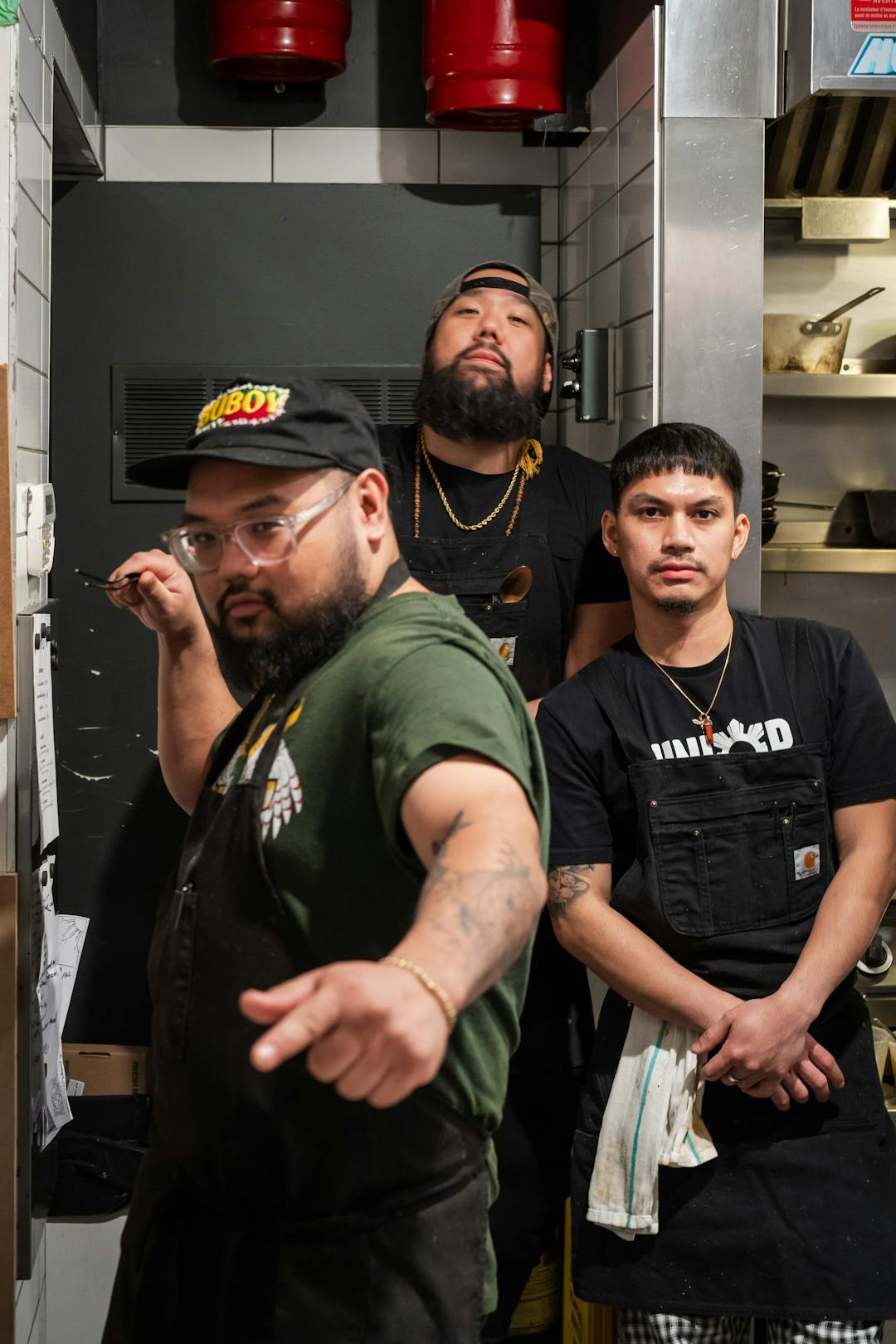Jun Jun: The hi-fi restaurant modernizing Filipino cuisine in Griffintown
Montreal's first modern Filipino restaurant brings together a supergroup of the community to create a new generational take on their cuisine and culture.
 (Left to right) Eric Lazaro Magno of Buboy, @zo_akeyno, and co-chef Neil John Gayo of Jun Jun. | Photograph: @generalchauchicken
(Left to right) Eric Lazaro Magno of Buboy, @zo_akeyno, and co-chef Neil John Gayo of Jun Jun. | Photograph: @generalchauchickenWhen Junior first opened in 2014, it was a break from the longstanding concentration of Filipino restaurants found around Côte-des-Neiges-Notre-Dame-de-Grâce, where Quebec's largest Filipino community can be found.
“Our goal was not to only be a good Filipino restaurant, but to be a good restaurant, period," says JoJo Flores, a co-owner of Junior. “We wanted to represent Filipino culture not only in food, but music, the liveliness of the atmosphere—to have it all in one place.”
But to date, Montreal hasn't seen the cuisine go beyond its traditional trappings—a reality that spurred the creation of the city's first modern Filipino restaurant, Jun Jun.
“Higher end Filipino restaurants have been more for the titas (aunties), the bougie and sophisticated crowds,” Flores explains. “It’s lacking in a lot of cities, including Montreal; we don’t see that level of focus on plating or quality ingredients often. With Jun Jun, we want to offer a new generational take on our cuisine.”

With Jun Jun, we want to offer a new generational take on our cuisine.
Hi-Fi(lipino)
Described as a contemporary play on the experience of eating Filipino cuisine, the 45-seat Jun Jun has taken over the spot that once housed the fine dining restaurant Chez Sophie.
A new menu, a redone bar with wine list and cocktails from Leslie Ann Roberts, replaced light fixtures, a few personal accents like the work of the local abstract artist Robert Rahal, and one new sound system later, the restaurant was opened.

Run by Bic Flores, JoJo Flores, and Toddy Flores with Jay Viau, Rey Mariano, and Zo Aquino in the front-of-house and head chefs Neil John Gayo and Lorenzo Aquino helming the kitchen, it's a highly collaborative entity that seeks to elevate Filipino culture in every respect, from taste to sound.
It's not just that JoJo has a background as a DJ, but music ties into the space on a deeper level.
“Filipinos are very musical. Most can sing or play guitar. It’s how we socialize and it’s part of how we get together," Flores says. "“I want to give clients a hi-fi experience where they can still have a conversation while enjoying the music. If you want to create a good ambiance, all your senses should be working in harmony.”
"That’s something we’ve done at Junior, where you can sing along to what’s playing, whereas Jun Jun is more of an immersion where you can hear jazz, soul, hip-hop, all within an hour of you being there.”
Jun Jun tells the story of where we’re coming from and what brought us to this point. At the heart of it, we’re Filipino, but the techniques and flavours we’ve learned along the way get combined, whether that’s our culinary training or what our grandmothers make.

The approach we’re taking is that we still want to offer Filipino flavours, but place them in dishes and aesthetics that are seen in the modern restaurant world.
Rewriting the Cookbook
For both chefs, Junior provided a springboard to discover and rediscover not only their backgrounds and home country's diverse cuisine, but how they could push it further.
“Filipino food traditionally—with all due respect to it—is a lot of stews with its one-pot cookery,” says Aquino, one of Jun Jun's two chefs who sports a background behind the bars of Ryu Sushi and Atwater Cocktail Club.
"The approach we’re taking is that we still want to offer Filipino flavours, but place them in dishes and aesthetics that are seen in the modern restaurant world."
“Jun Jun tells the story of where we’re coming from and what brought us to this point. At the heart of it, we’re Filipino, but the techniques and flavours we’ve learned along the way get combined, whether that’s our culinary training or what our grandmothers make.”

For Jun Jun's other chef, the born-and-raised Filipino Montrealer Neil John Gayo, it's a way of uncovering a side of himself he hadn't cooked professionally until recently, committing to Junior’s kitchen during the pandemic after years of working in American kitchens.
“When I started cooking, it was French and American food, but with Junior I could represent my culture and home country," Neil says.
"Here, I can show people that Filipino food is everything but cheap, and that it can compete with other cuisines. It’s my mission as a Filipino, and every dish I make is for my family, and is inspired by my grandparents.”

Here, I can show people that Filipino food is everything but cheap, and that it can compete with other cuisines.
Setting a New Main Course
“Filipino cuisine is a mix of everything. We’ve been colonized by Spaniards, Americans, China—it’s all of them combined together,” says Gayo.
While Jun Jun fully embraces Filipino cuisine’s inherent cross-cultural qualities, it spins them further: Anyone unaffiliated with Filipino food will often find that by googling the name of a dish off Jun Jun's evolving menu will show something entirely different—what was once a stew, a soup a dessert, or a ceviche has become the inspiration for something entirely different, yet the touchpoints of flavour remain in subtle ways.

“With Jun Jun, it’s not traditional. We’re using different techniques to infuse the cuisine with others, like our duck adobo. Usually we’ll use pork or chicken with vinegar and spices in that dish, but here, we added fruits and tweaked the sauce to be more like Peking duck’s herbs and spices.”
Aquino also points to the restaurant's bulalo carpaccio, which turns the traditional beef shank soup of shanks and marrow with corn on the cob into a plate of thinly sliced tenderloin topped with a marrow-demi mayo, a grilled corn salad, and fermented cabbage.


“This is where I wanted to revamp Filipino food. Whenever a Filipino looks into a Filipino restaurant, they’ll usually see traditional food, but here?" Gayo says. "We can show that it doesn’t need to be that way."
Aquino chimes in: “We can show here that yes, it can be comfort food, but these flavours can pair well with what you’ll find in high-end restaurants. We can elevate it, prepare it à la minute, and compete with any other culture here.”
In time, Gayo will be bringing his experience as a pastry chef, in baking, and hi side hustle under the name NJOY Filipino Treats to the menu as well to explore that side of the cuisine as well.
Jun Jun is located at 1974 Notre-Dame Street West.

![The Bulletin: A match made in Montreal [Issue #62]](/_next/image?url=https%3A%2F%2Fthemain.ghost.io%2Fcontent%2Fimages%2F2024%2F02%2F01_VM94-EX184-008-1.jpg&w=640&q=75)